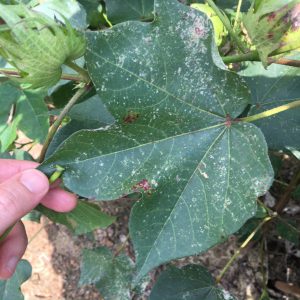I’m beginning to think the Government is going to shut me down for operating on wetlands.
Cotton: Bacterial Blight has been identified in some surrounding counties. Don’t be blinded by the blight (Kemerait likes catchy phrases), the only way to effectively combat it is with resistant varieties. Target spot is rampant and Areolate mildew is catching up. If areolate mildew occurs early it can affect yield and it’s easier to treat than target spot. Azoxystrobin works well on areolate mildew. We have some June cotton that is just starting to bloom and has not been side-dressed yet. Since the cotton is just starting to bloom there is time to still apply some N and K. 30-50lbs of N to the soil and foliar feed the K. At this time, even with soil-applied N, I would be prepared to foliar N and K after the 3rd week of bloom. If your June cotton has been blooming for 3 weeks with no side-dress applied, I would still go the 30-50lbs of N soil application route. You’re only looking at 4-6 weeks left of potential boll setting so you don’t want to go too high of a rate. Again each situation is different depending upon soil type, how much water you’ve had, and how much fertilizer has already been applied. Call me and we can talk through it. Many cloudy days here lately have caused some fruit shed. The lower light conditions reduce the number of carbohydrates and the plant decides to abort some fruit it knows it cant support. Also, root development has been reduced due to the waterlogging of plants. This results in reduced nutrient uptake and can contribute to fruit shed.

Areolate Mildew
Weather: The tropics have been rather quiet this past month but the main tropical development period is between August and October. Long-range models are starting to show storms developing in the main development area in the Atlantic. African waves coming west are increasing which aids in the development of storm systems. We are in La Nina watch. Meteorologists forecast a possible La Nina this fall/winter which means we can expect warmer and drier conditions.
Cattle: The cattle market has been looking better. Cattle inventory report came out recently and showed where total cow numbers were down. This means that herds have been in sell mode over the past several months. With fewer cows on the farm, this creates a supply issue on calves, giving a bullish outlook on calves in the future. Again, there are many variables with demand/supply issues, but I think the feeder calf market could increase if corn prices hold.